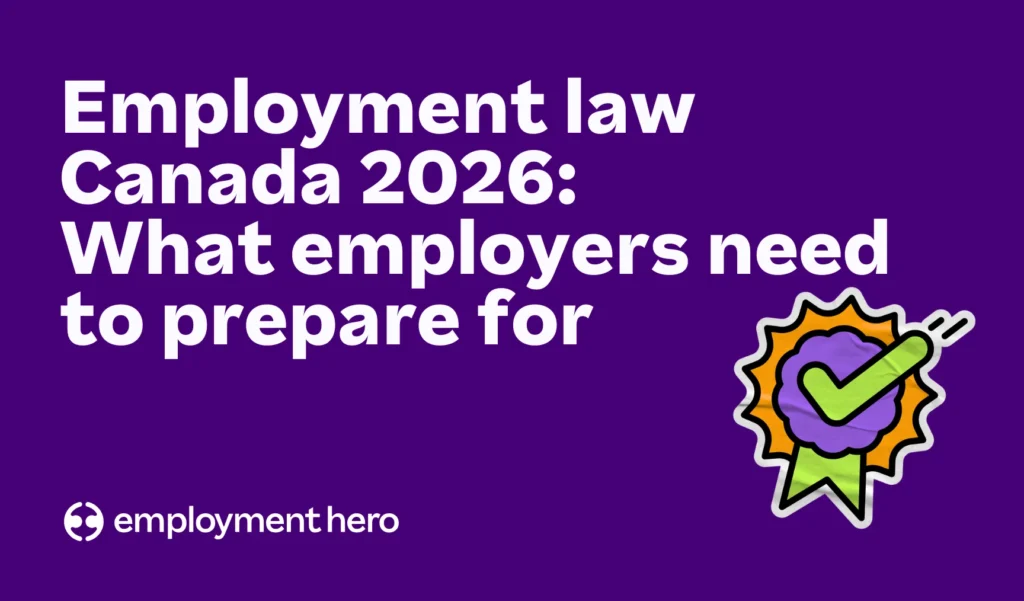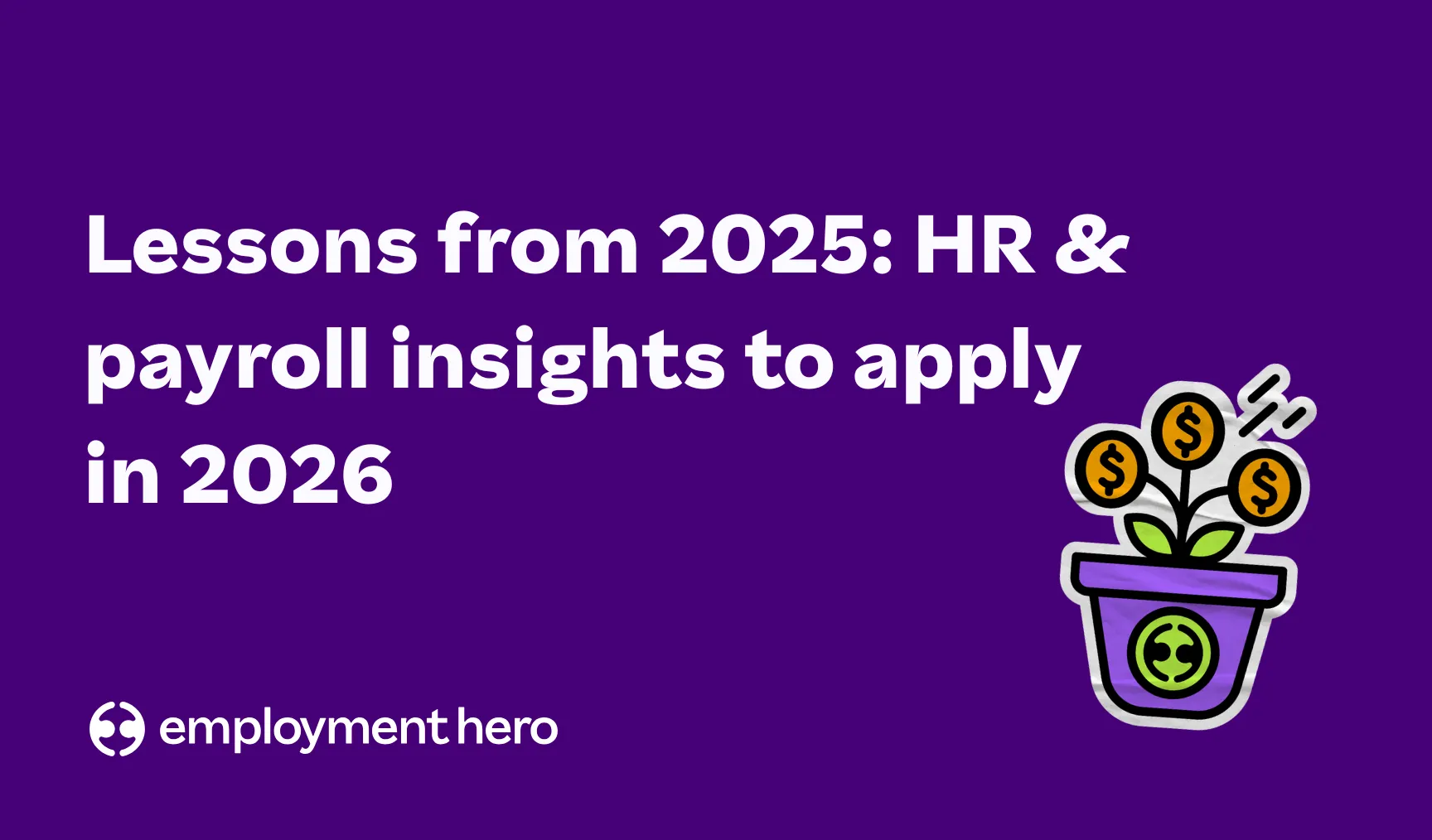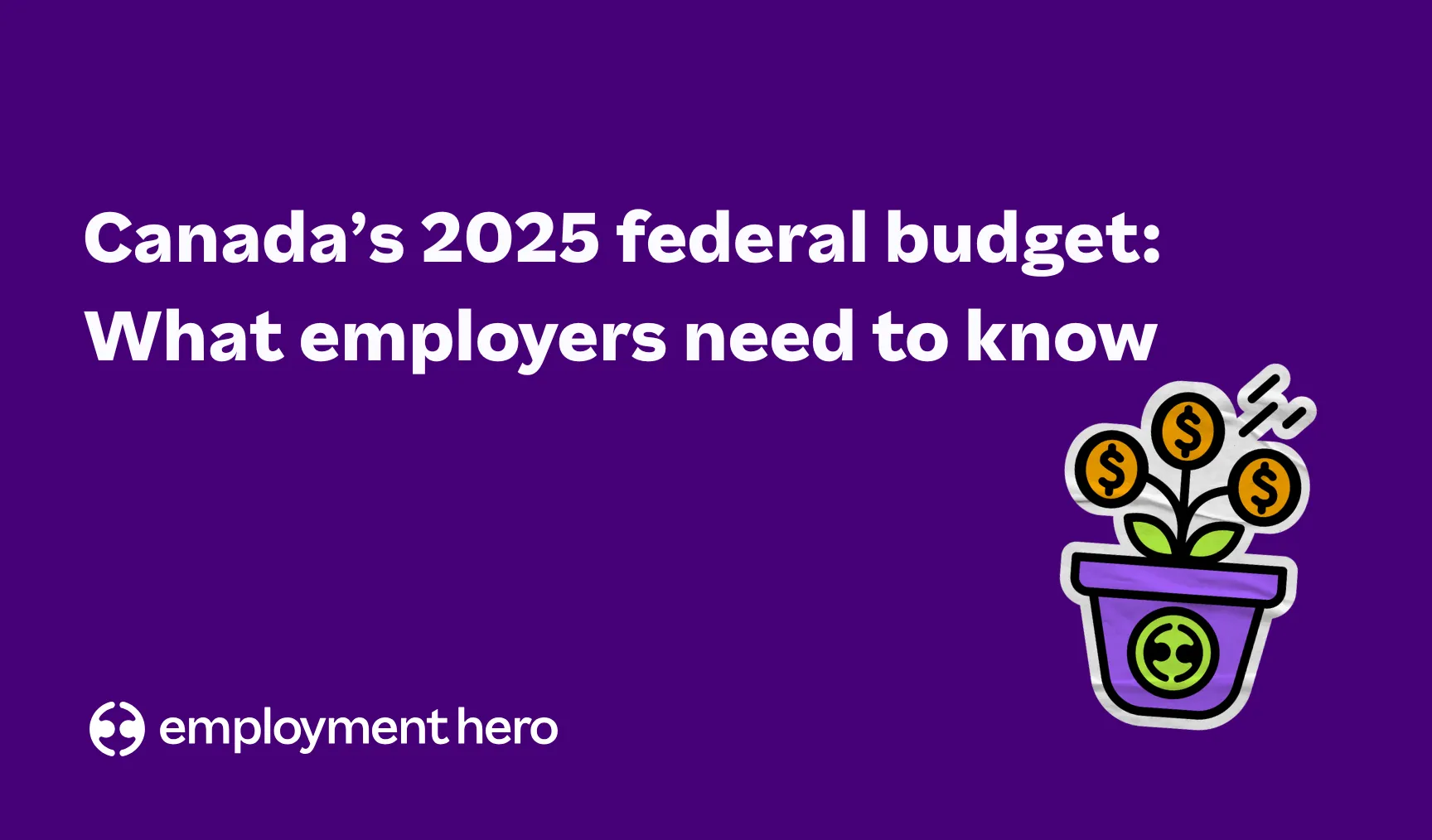Employment law Canada 2026: What employers need to prepare for
Stay ahead of Canadian employment law changes in 2026. Learn about updates to the ESA, OHS, federal labour code and new protections.

Contents
The start of a new year always brings big shifts in Canadian employment law, and 2026 is no exception. For you, the SME employers who drive our economy, staying ahead of these changes isn’t just about avoiding a fine. It’s about creating a fair, resilient workplace where your team can thrive.
The name of the game for 2026 is transparency in hiring, mobility for workers and leveling up health and safety. These changes are being driven by a constant flow of provincial acts (we’re looking at you, Ontario!) and federal rules, so it’s time to revisit and hit refresh on your policies and systems now.
In this blog, we offer a close look at the key employment law Canada 2026 changes that you need to stay updated on to maintain a compliant workplace, as well as a checklist to help you stay ahead of any changes.
Canada Labour Code amendment for federally regulated employers
If you run a federally regulated business—think banking, telecom or inter-provincial transportation—your focus needs to be on wage equity and fairness.
The main focus for late 2025/early 2026 is the implementation of Equal Treatment Wage Rules with the following proposed updates:
- Equal pay for equal work: These rules shut the door on paying part-time, seasonal or temporary (fixed-term) employees less than their permanent, full-time colleagues when they do the same kind of work under similar conditions. This is a crucial move to fix precarious employment.
- Temporary Help Agency (THA) rules: Federally regulated THAs and their clients cannot pay THA employees a lower wage rate than the client pays its direct employees for the same work.
- Employee right to review: Your employees get a clear path to request a review of their wage rate. You must respond to them in writing within 90 days, either explaining the difference or showing your plan for a wage increase.

For employers operating in Ontario, these federal updates are just one piece of the 2026 compliance puzzle. The provincial government is ushering in its own set of major reforms through the Working for Workers Seven Act.
Ontario’s Working for Workers Seven Act updates
Ontario’s Working for Workers Seven Act, 2025 continues the trend of legislative reform aimed at protecting employee rights and increasing transparency. While some parts of the Working for Workers series (like those concerning job postings) took effect in earlier acts, the latest Bill focuses on protections, hiring transparency and safety.
Here are the key changes from the Working for Workers Seven Act (and related WfW Acts with 2026 dates):
- Job seeking leave: If you have to conduct a mass layoff (terminating 50 or more employees at an establishment), affected employees now get three days of unpaid leave to use during their notice period to hunt for new jobs. It’s a new, important obligation during tough transitions.
- Extended layoff provisions: The Act introduces a way to permit extended layoffs of 35 or more weeks within a 52-week period (but less than 52 weeks in 78) if the employer and employee agree and the Director of Employment Standards approves. This provides a temporary path for employers facing economic difficulty.
- Combatting job scams: This change is a win for job seekers. It puts the heat on job posting platforms to have a clear system for users to report fraudulent postings and a written policy on how they deal with them.
- WSIB fraud prevention: Amendments to the Workplace Safety and Insurance Act, 1997 prohibit employers from making false or misleading statements to the WSIB in connection with an employee’s claim, with severe penalties for contravention.
The Working for Workers Seven Act continues Ontario’s legislative momentum, but you must also finalize preparations for equally vital compliance deadlines from earlier bills. Specifically, the Proposed Employment Standards Act Modifications bring major changes to hiring transparency, effective in January 2026.
Proposed Employment Standards Act modifications
This is a big one. The core of the provincial updates for 2026, stemming from the Working for Workers Four and Five Acts, centers on recruitment transparency in the Ontario Employment Standards Act, 2000 (ESA). These changes mainly apply to employers with 25 or more employees on the day the job posting is published.
Here are the new requirements under the ESA that will come into effect in Ontario as of January 2026:
| New ESA requirements (Effective Jan. 1, 2026) | Employer action required |
| Mandatory compensation disclosure | All publicly advertised job postings must disclose the expected compensation or a salary range. The maximum range allowed is $50,000 annually (e.g., $70,000 – $120,000 is compliant, but $50,000 – $110,000 is not). This is exempt for positions where the expected compensation exceeds $200,000. |
| Ban on “Canadian Experience” | You can’t require Canadian work experience in job postings or application forms anymore. This is a huge step toward welcoming global talent. |
| Disclosure of AI Use | If you use Artificial Intelligence (AI) to screen, assess or select job applicants, you have to disclose it in the public job posting. |
| Clarify vacancy status | Job postings should state whether the posting is for an existing vacancy or for a future/anticipated hire. |
| Candidate communication | Employers need to inform all applicants who are interviewed whether a hiring decision has been made for the advertised position. This must be done within 45 days of the interview (or the last interview). |
| Record-keeping for postings | Employers must retain copies of every publicly advertised job posting and the information provided to interviewed applicants for three years. |
While you review your hiring processes to meet the new fairness standards, you also have an ongoing responsibility to foster a physically safe workplace. Here is how the Proposed Occupational Health and Safety Act changes require you to enhance your site safety, hygiene and accountability in 2026.
Proposed Occupational Health and Safety Act changes
Safety standards are seeing constant changes and enhancements, particularly in high-risk industries like construction. Here is how the Proposed Occupational Health and Safety Act (OHSA) changes require you to enhance your site safety, hygiene and accountability in 2026.
- Mandatory AEDs (Automated External Defibrillators) on construction sites: Larger construction projects now must have AEDs onsite. This life-saving equipment ensures timely help during a cardiac emergency.
- Washroom facility cleanliness records (Effective Jan. 1, 2026): Following a 2025 requirement to maintain clean and sanitary washrooms, employers and constructors must now keep and post a record showing the date and time of the two most recent washroom cleanings or post the record electronically where workers can readily access it.
- Increased fines for corporations: The maximum fine for corporations convicted of a second or subsequent OHSA offense resulting in death or serious injury remains $2,000,000, but a new minimum fine of $500,000 has been introduced for these grave repeat offenses.
As you can see, managing compliance in Canada is a complex, province-by-province, rule-by-rule challenge. With new laws taking effect on pay transparency, gig worker rights and payroll record-keeping, relying on manual processes and spreadsheets introduces unnecessary risk and wastes valuable time.
Employment Hero is your comprehensive Employment Operating System (EOS), designed for Canadians to handle this regulatory complexity on autopilot. It brings together all your HR processes in one powerful platform so you can ditch fragmented tools and manage it all under a single login.
Stop reacting to change and start leading with confidence!
Ready to automate compliance and HR admin?
Proposed Workplace Safety and Insurance Act amendments
The WSIB (Workplace Safety and Insurance Board) system is also adapting to better support workers and ensure employer compliance. The key amendments focus on transparency and benefit eligibility:
- Prohibition of false statements: New provisions in the Workplace Safety and Insurance Act, 1997 explicitly prohibit employers from making false or misleading statements to the WSIB concerning an employee’s benefits claim, backed by administrative penalties.
- 2026 Average Premium Rate: The average premium rate for Ontario businesses in 2026 will be $1.23 per $100 of insurable payroll. This is a further reduction from the 2025 average rate of $1.25
- Changes to presumptive cancer entitlements: Amendments, with some coming into effect in 2025, reduce the required service duration for firefighters to claim presumptive benefits for certain cancers (like kidney and colorectal cancer) under the Act.
After reviewing the traditional insurance and safety framework, it’s essential we address the newest area of employment regulation: the gig economy. Your obligations extend to this evolving sector with the full enforcement of the Digital Platform Workers’ Rights Act (DPWRA)
Digital Platform Workers’ Rights Act implementation
The Digital Platform Workers’ Rights Act, 2022 (DPWRA) is a game-changer. While it officially came into force in Ontario on 1 July 2025, 2026 is the first full year of its enforcement. This legislation extends basic rights to gig workers (like Uber and SkipTheDishes drivers) regardless of their contractor status.
“Operators” of digital platforms must adhere to new obligations:
- Minimum wage: Operators must pay the ESA minimum wage for the time the worker is performing a work assignment.
- Regular pay period: Workers must have a regular pay period and pay day.
- Written information: Operators must provide written information to workers regarding how their pay is calculated and how performance ratings might affect their access to work.
- Notice of removal of access: Workers must receive a written explanation if their access to the platform is removed for 24 hours or more and two weeks’ written notice for longer removals (unless a reason like willful misconduct applies).
- Right to written information: Workers are entitled to receive information about their pay, performance and the dates/times of their work assignments.
Now, let’s look at the regulatory changes coming into effect in different provinces:
Province-by-province snapshot for 2026
While Ontario is leading the charge with significant regulatory changes, SMB leaders (that’s you!) know to check the temperature across the entire country. Here’s a quick look at what’s driving the compliance agenda coast-to-coast:
| Province | Major 2026 (or near-term) focus |
| Ontario | Pay Transparency (job postings), AI disclosure in hiring, ban on Canadian experience requirement, new mandatory candidate communication, DPWRA enforcement for gig workers. |
| Federal | Equal pay for equal work rules for part-time/temporary employees, Right to Disconnect policy requirements. |
| British Columbia (BC) | Ongoing focus on Pay Transparency Act compliance, including internal pay equity reporting and mandatory salary disclosure in job postings. |
| Alberta | Continuing focus on regulatory modernization, including potential updates to hours of work and overtime rules (always check the latest for minimum wage adjustments). |
| Quebec | Focus on worker classification and the potential expansion of rights for temporary agency workers and increased enforcement of workplace psychological harassment laws. |
| Newfoundland & Labrador (NL) | WHS Certification Incentives: Full implementation of WorkplaceNL’s PRIME Path 2 (OHS Certification) requirements for larger employers ($10k+ in assessments and 20+ workers) to qualify for premium refunds (Effective Jan 1, 2026). Minimum Wage: Mandatory annual minimum wage increase (expected April 1, 2026). |
| Prince Edward Island (PEI) | Minimum Wage: Scheduled minimum wage increase to $17.00/hour (Effective April 1, 2026). |
So, how do you keep track of so many changes and most importantly, where do you start? Here’s a checklist to give you a good starting point so you can focus on critical compliance areas and prepare for the changes in legislation.
Essential considerations for employers
You’ve got a lot on your plate. With all these changes rolling out across the country, a centralized, strategic approach isn’t optional—it’s essential. Hit these critical compliance areas to prepare for the 1 January 2026 deadlines and beyond:
- Update job posting templates: Audit all publicly advertised job posting templates to ensure they include mandatory compensation details, AI disclosure, vacancy status and remove any mention of requiring “Canadian experience.”
- Revise onboarding and hiring policies: Implement a new process for documenting and delivering the hiring decision status to all interviewed candidates within 45 days.
- Audit employment contracts: For Ontario employers with 25 or more staff, ensure your employment agreement templates and onboarding packages include all the new prescribed pre-employment information (legal name, contact details, work location, starting wage, etc.) effective mid-2025.
- Develop or review RTD policies: Federally regulated employers must finalize and implement their Right to Disconnect policy in consultation with employees or unions.
- Adjust payroll systems for federal equal pay: Federally regulated employers must review compensation for part-time, seasonal and contract workers to ensure no prohibited differential wage rates exist based on employment status.
- Strengthen record-keeping: Implement new systems to retain job postings, applications and all candidate communication records for the prescribed three-year period.
- Mandatory training: Ensure all HR staff and hiring managers are thoroughly trained on the new job posting rules, candidate communication requirements and anti-reprisal provisions.

Navigating these complex changes successfully is your priority, but it’s equally important to understand what’s at stake. Let’s look at the financial consequences and penalties associated with non-compliance, ensuring you have a full picture of your legal obligations and risk exposure
Employment law enforcement and penalties
The government’s commitment to these new standards is underlined by increased enforcement and steeper penalties. In Ontario, fines for ESA violations have already significantly increased, with the maximum fine for corporations doubling to $100,000 for a single violation. Furthermore, fines for repeated and severe OHSA violations resulting in worker injury or death now have a $500,000 minimum for corporations.
Compliance is not just a matter of good faith; it is a financial necessity to mitigate the serious risks associated with non-compliance, including administrative monetary penalties, public enforcement proceedings and reputational damage.
So, how do you stay ahead of these compliance updates and avoid these penalties?
How employers can stay ahead
The volume and velocity of change in employment law Canada 2026 can feel overwhelming, but a proactive strategy can simplify compliance:
- Proactive monitoring: Appoint an internal team or a dedicated external partner to monitor legislative updates in your jurisdiction continually. Do not wait for laws to come into force.
- Legal subscriptions and resources: Invest in legal factsheets, newsletters and services that provide timely, accessible summaries of the law.
- Internal training and communication: Conduct mandatory training for all managers and HR staff on the new job posting requirements, particularly the rules around pay transparency and AI disclosure.
By understanding the shifting priorities—from pay transparency in recruiting to equal treatment in pay and enhanced safety standards—you can ensure your organization is positioned for stability and success in the year ahead.
But, having doubts and questions is totally understandable. We’d love to help. With Employment Hero HR advisory services, you can get HR advice from real experts in Canadian employment law, so you’re never in doubt about the ever-changing compliance landscape and can stay on top of all legislation changes. We offer actionable, clear advice that works for your business to answer all your questions and provide jargon-free, actionable insights.
Partner with us to lead with confidence and build a world-class culture.
Related Resources
-
 Read more: Payroll insights and HR lessons from 2025: Your 2026 guide
Read more: Payroll insights and HR lessons from 2025: Your 2026 guidePayroll insights and HR lessons from 2025: Your 2026 guide
Discover key HR and payroll insights from 2025 to guide your 2026 strategy. Learn about compliance updates, trends and best…
-
 Read more: 2025 federal budget: What Canadian employers need to know
Read more: 2025 federal budget: What Canadian employers need to know2025 federal budget: What Canadian employers need to know
Discover what Canada’s 2025 federal budget means for employers, from enhanced SR&ED incentives to new talent and funding opportunities.
-
 Read more: What tech founders should know about the 2025 federal budget and why this year is the perfect time to double down on SR&ED
Read more: What tech founders should know about the 2025 federal budget and why this year is the perfect time to double down on SR&EDWhat tech founders should know about the 2025 federal budget and why this year is the perfect time to double down on SR&ED
Discover how the 2025 federal budget enhances SR&ED for Canadian startups. Learn how founders can maximize refunds, extend runway and…


















